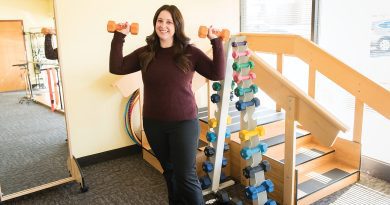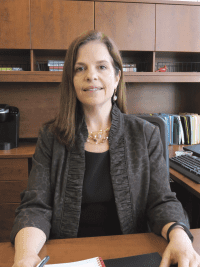From Transition to Integration – Making Wing Part of the Baystate System
On Labor Day, Wing Memorial Hospital — the name that’s been over the door of the Palmer institution for more than a century — became Baystate Wing Hospital.
The change, which has been in the works for several months now, became official at 12:01 in the morning, and was marked a few days later with a fairly simple set of ceremonies.
There was an unveiling of sorts of new signage, not only at the main entrance to the hospital, but also on the Mass. Turnpike, not far from the turnoff for exit 8, and elsewhere. There were a few speeches, and a number of Baystate Health officials were on hand to meet and greet new members of the system’s team.
While it seemed rather simple, this transition has actually been quite complex and time-consuming, said Dennis Chalke, who has long held the title chief financial officer and treasurer of the Baystate system, and recently added ‘senior vice president of Community Hospitals’ to his business card.
He used both words and numbers to get that point across.
“To offer a sense of the complexity of all this, we had 50 to 60 people meeting weekly for months, representatives from Wing and Baystate, and, in some cases, from UMass Memorial Health Care (the previous parent company) to discuss all the things that had to happen for this acquisition to go off smoothly,” he told HCN. “We had a document that was 50 pages long, with six to eight initiatives on each page, that had to be completed for this to go smoothly.
“Wing had 44 IT systems, and some of these were provided by the UMass system, and some of them provided locally at Wing; the challenge was, ‘how do you extricate Wing from UMass, and how do you bring their software system onto your software system?” he went on, adding that the process of bringing the hospital under the Baystate umbrella is exponentially more complicated than the last time the system went through it — in 1991, with nearby Mary Lane Hospital in Ware, now Baystate Mary Lane.
In many ways, the work is just getting started, noted Chalke, who said the assignment essentially shifted when the new name went up — from transitioning Wing to the Baystate system and its so-called Eastern Region, to integration.
He used that term to describe everything from merging all those IT systems to incorporating Wing into long-term strategic initiatives for the health system, aimed at providing more and better services for the residents of that region; from facilitating the process of recruiting doctors and other healthcare professionals to Wing and Mary Lane, to furthering and in some ways simplifying Baystate’s broad efforts in the realm of population health.
For this issue, HCN looks at the process of making Wing part of the Baystate System, the work that’s been done, and the initiatives still to be undertaken.
Expanding the Horizon
Chalke, the first holder of that title ‘vice president of Community Hospitals,’ said the Baystate system has long used the term ‘Eastern Region’ to describe Mary Lane — ‘Northern Region’ is used with regard to Baystate Franklin Medical Center in Greenfield — but now, the phrase takes on new meaning.
It refers to two community hospitals roughly 12 miles apart, with Mary Lane traditionally serving residents who live north of the Mass. Pike, said Chalke, and Wing serving those who live south of the thoroughfare, with some overlap. They have historically been competitors, to one degree or another, but also competitors with larger facilities in both the Springfield and Worcester areas, he noted.
They are now part of the same system, a development that should bring some opportunities to better serve people across what’s known as the Quaboag region and beyond, keep more people in that area from traveling to Worcester or Boston for care, and also enable the Baystate system to enhance its efforts in population health, he told HCN.
Before elaborating on all that, Chalke talked at length about the transition process, which obviously involves much more than putting a new sign over the main entrance. And it was made somewhat more complicated by the fact that Wing was part of another system.
“Typically, with most of these deals that take place where a hospital joins a system, it’s a free-standing hospital joining a system,” he explained. “And because the hospital was free-standing, it had its own infrastructure, which you could bring into a system over time as it made sense. The challenge with the Wing acquisition is that it was part of another system, and Wing relied on UMass for certain services.”
Thus he used the word ‘extricate’ in a few instances as he talked about the many steps in this initiative, adding that this is an ongoing process and that UMass will continue to provide some IT services to Wing until those systems are moved onto Baystate’s.
Matters were further complicated by the fact that Baystate could not gain access to some information — such as managed-care rates and supply costs — until the deal was approved, because Wing and Baystate are technically competitiors, and would continue to be so if the acquisition was not approved.
Overall, the transition process involves a number of operational areas, as that 50-page document reveals, including everything from clinical systems to human resources; from financial policies to supply-chain issues; from employee benefits to the badge numbers worn by team members.
Perhaps the most difficult transition assignment involves clinical systems, he went on, noting that Wing currently uses different electronic medical record (EMR) systems for inpatient and outpatient care, and the Baystate system uses a different product for both.
And, as Chalke noted, the process has become much more complicated over the past 23 years, primarily due to advancing communications technology.
“It’s a much more involved process,” he said. “Back then, medical records were paper, now everything is electronic. There are those 44 IT systems, but there are many other issues that we had to address, including clinical issues, coverage issues, HR, differences in benefits, and much more.
“Some of these aren’t day one,” he went on. “Some will take place over a year or two, or even three years, but many were in place on Sept. 1.”
Adding Things Up
Moving forward, while there are some transition issues to be finalized, the process now shifts in some ways to integration, said Chalke, adding that corporate, or operational, culture is always an issue in such acquisitions, but early indications are that the two institutions “mesh,” as he put it.
“Culture is always a hurdle, it’s always an unknown, because it’s something you can’t put down in a document,” he told HCN. “But the teams have come together fantastically, and we’ll be very successful going forward in terms of matching up the cultures.”
Another assignment for the system is to aggressively and effectively market the Eastern Region, letting people know what has changed, and what hasn’t, said Chalke, adding that a campaign to promote the brand and gain market share — primarily by keeping people in the Ware/Palmer area for care rather than going to Worcester or other Western Mass. providers — is being put together.
“We’re going to identify the services that both Baystate Wing and Baystate Mary Lane have to offer, and attempt to capture additional market share in that region,” he said, adding that the tone of that campaign and its specific message are being developed.
But the primary task at hand is to enable the newly constituted Eastern Region to better serve that part of the state, said Chalke, noting that this assignment will fall primarily to Dr. Charles Cavagnaro, long-time president and CEO of Wing, who is now president of the Eastern Region, and Dr. Shafeeq Ahmed, who will serve as chief medical officer for the region, among other titles.
In many instances, one plus one might equal three when it comes to the impact of bringing these hospitals together, said Chalke, who cited one simple example of this new math.
“Mary Lane has two surgeons, and Wing has two surgeons,” he explained. “Historically, they would have to be on call every night. Now, they can cross-cover, and they can be on call every fourth night. That’s just one example of how we can better attract physicians now, because the demands will be less strenuous than they would have been if these were standalone hospitals. We think there will be a number of benefits from these hospitals coming together.”
Meanwhile, Springfield is considerably closer to Palmer than Worcester, he went on, adding that this will make it easier for Baystate to rotate specialists in and out of Wing and provide other types of support to both hospitals in the Eastern Region.
“We think we can much better serve the people of that area in this fashion,” he went on. “It’s clearly a win-win.”
When asked how Baystate Health itself, which is now a nearly $2 billion operation and the fourth-largest healthcare system in the state, benefits from controlling two hospitals only 12 miles apart, Chalke said the Affordable Care Act brings additional pressure on systems to better manage population health, and this is more attainable when a provider has greater control over how care is delivered in a given area.
“We’re being paid, in some cases, to take care of a population, and we’re at risk for taking care of a population,” he explained, “and it’s much easier to do that if you own the facilities and have relationships with the physicians in that area, as opposed to some health systems that are trying to manage facilities and populations from a great distance; this makes for a better opportunity to be more successful at population health under healthcare reform.”
Having two hospitals so close together might present opportunities to eliminate duplication of services and make the Eastern Region more efficient overall, Chalke said, adding that operations have been reviewed, but no decisions have been made with regard to clinical services.
“Right now, we think there’s opportunity to grow both hospitals by keeping patients local and providing the care locally,” he said. “And we believe that, by beefing up the medical staffs of the two organizations, we can keep more people here, in this area — there’s a lot more that these hospitals can do together.”




